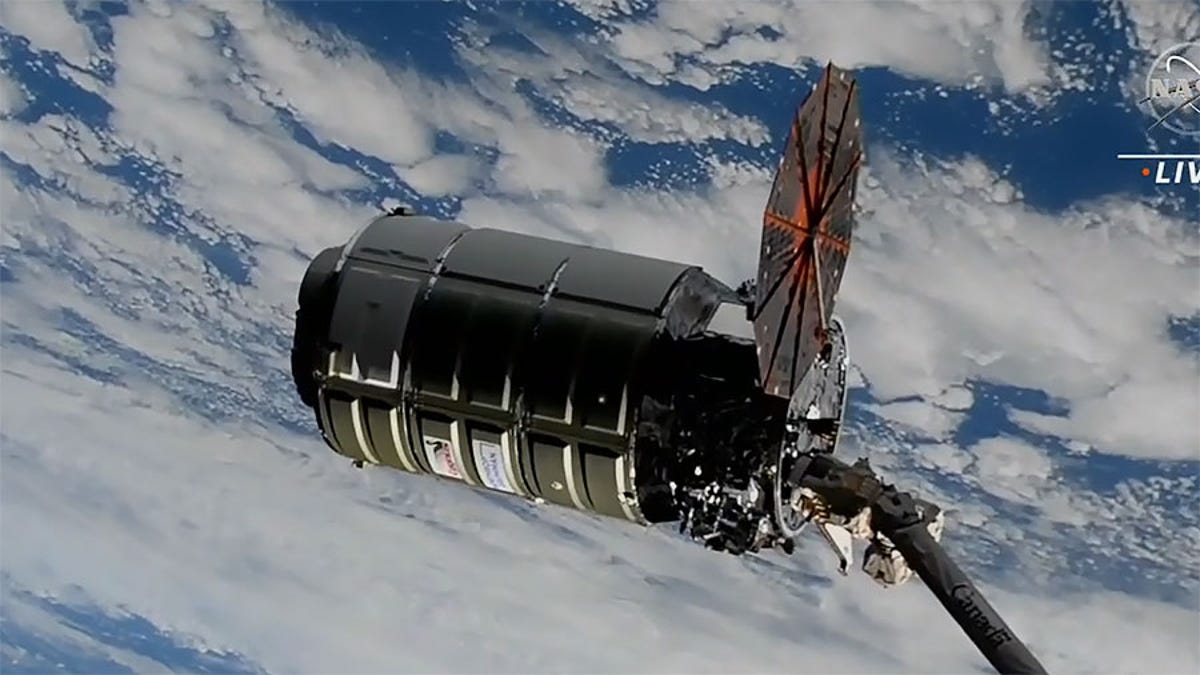Cygnus Cargo Craft Makes It to Space Station After Unusual Travel Glitch
Whew. NASA and Northrop Grumman pulled off the ISS arrival of a space freighter with only one working solar array.

A screenshot from NASA TV shows the Cygnus spacecraft during capture by the ISS robotic arm. Only one solar array is open.
There were some tense moments over the last few days as Northrop Grumman's NG-18 Cygnus space freighter journeyed to the International Space Station after a major glitch. Only one of the spacecraft's two solar arrays unfurled, but NASA announced the cargo craft had pulled off a successful docking maneuver on Wednesday morning.
Cygnus is loaded with 4 tons of hardware, crew supplies and research equipment. It launched from Virginia on Monday morning. The ISS crew captured the spacecraft using a robotic arm and installed Cygnus on an available port.
NASA tweeted a video of the capture that clearly shows only one of the round solar arrays open.
Piloted by @AstroDuke the robotic arm of the @Space_Station has successfully captured the Cygnus spacecraft carrying dozens of new scientific experiments and food. Next step: spacecraft installation to the Unity module’s Earth-facing port. pic.twitter.com/O0mAg4Ob8o
— NASA (@NASA) November 9, 2022
NASA announced the solar array glitch in a short statement on Monday, saying Northrop Grumman was gathering data on the second array deployment and working closely with the space agency to investigate what happened. Northrop Grumman said the spacecraft had sufficient power to rendezvous with the ISS as scheduled. That assessment ended up being accurate.
The uncrewed cargo craft uses fold-out solar arrays that tuck away during launch and later open up like circular fans. A Northrop Grumman video from 2015 shows what the process looks like.
This particular Cygnus spacecraft is named the S.S. Sally Ride in honor of the first American woman in space. It's carrying some intriguing experiments related to 3D-printing human tissue and growing plants in microgravity.
A Cygnus cargo spacecraft doesn't return to Earth. The crew typically packs it up with trash before it undocks, reenters Earth's atmosphere and burns up, like an elaborate garbage disposal system. The newly arrived Cygnus will stay in residence at the ISS until late January.
Solar arrays in space can be tricky. NASA's asteroid-focused Lucy spacecraft experienced a problem with fully deploying one of its fan-like solar arrays after it launched in 2021. The spacecraft is proceeding on its mission despite the issue.
The S.S. Sally Ride has some very valuable cargo on board, including a mounting bracket needed for an upcoming spacewalk. NASA and Northrop Grumman will continue to scrutinize the solar array glitch in hopes of preventing another issue on a future mission.

